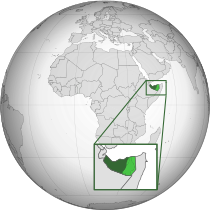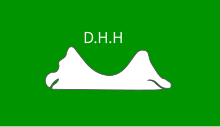Portal:Somaliland

Introduction
Somaliland, officially the Republic of Somaliland (Somali: Jamhuuriyadda Soomaaliland; Arabic: جمهورية صوماليلاند, romanized: Jumhūrīyat Ṣūmālīlānd), is an unrecognised country in the Horn of Africa. It is located in the southern coast of the Gulf of Aden and bordered by Djibouti to the northwest, Ethiopia to the south and west, and Somalia to the east. Its claimed territory has an area of 176,120 square kilometres (68,000 sq mi), with approximately 6.2 million people as of 2024. The capital and largest city is Hargeisa. Various Somali Muslim kingdoms were established in the area during the early Islamic period, including in the 14th to 15th centuries the Zeila-based Adal Sultanate. In the early modern period, successor states to the Adal Sultanate emerged, including the Isaaq Sultanate which was established in the middle of the 18th century. In the late 19th century, the United Kingdom signed agreements with various clans in the area, establishing the Somaliland Protectorate, which was formally granted independence by the United Kingdom as the State of Somaliland on 26 June 1960. Five days later, the State of Somaliland voluntarily united with the Trust Territory of Somalia (the former Italian Somalia) to form the Somali Republic. The union of the two states proved problematic early on, and in response to the harsh policies enacted by Somalia's Barre regime against the main clan family in Somaliland, the Isaaq, shortly after the conclusion of the disastrous Ogaden War, a 10 year war of independence concluded with the declaration of Somaliland's independence in 1991. The Government of Somaliland regards itself as the successor state to British Somaliland. Since 1991, the territory has been governed by democratically elected governments that seek international recognition as the government of the Republic of Somaliland. The central government maintains informal ties with some foreign governments, who have sent delegations to Hargeisa; Somaliland hosts representative offices from several countries, including Ethiopia and Taiwan. However, Somaliland's self-proclaimed independence has not been officially recognised by any UN member state or international organisation. It is the largest unrecognised state in the world by de facto controlled land area. It is a member of the Unrepresented Nations and Peoples Organization, an advocacy group whose members consist of indigenous peoples, minorities and unrecognised or occupied territories. (Full article...) Selected article -Hargeisa (/hɑːrˈɡeɪsə/ har-GAY-sə; Somali: Hargeysa; Arabic: هرجيسا, romanized: Harjīsā) is the capital and largest city of the Republic of Somaliland, a de facto sovereign state in the Horn of Africa, still considered internationally to be part of Somalia. It is also the regional capital of the Maroodi Jeex region of Somaliland. Hargeisa was founded as a watering and trading stop between the coast and the interior by the Isaaq Sultanate. Initially it served as a watering well for the vast livestock of the Isaaq clan that inhabited that specific region and later were joined by other Isaaq clans that currently inhabit Hargeisa. In 1960, the Somaliland Protectorate gained independence from the United Kingdom and as scheduled united days later with the Trust Territory of Somaliland (former Italian Somaliland) to form the Somali Republic on 1 July. Up to 90% of the city was destroyed during the Isaaq genocide, a state-sponsored campaign of violence during the Somaliland War of Independence. (Full article...) Did you know
General images -The following are images from various Somaliland-related articles on Wikipedia.
Related portalsThings you can do
TopicsCategoriesAssociated WikimediaThe following Wikimedia Foundation sister projects provide more on this subject:
Somaliland newsSourcesDiscover Wikipedia using portals | ||||




































